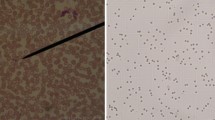Abstract
The objective of this study was to investigate the in vitro effect of Vipera lebetina venom on human erythrocytes’ osmotic fragility with respect to different venom concentrations, time of incubation with the venom, initial volume of red blood cells, and presence of antivenom. In vitro osmotic fragility of human erythrocytes was determined using Dacie and Lewis method. Osmotic fragility is increased significantly after incubation with the venom at different concentrations. The maximal effect was detected at the venom concentration of 400 μg. Time of incubation with the venom was an important factor in hemolytic process while the initial cell volume has no significant effect. Incubation of envenomed erythrocytes for 120 min with antivenom did not reverse the changes in osmotic fragility induced by the venom. The study suggests that the venom could alter the susceptibility of erythrocytes to hemolysis when subjected to osmotic stress and the degree of hemolysis depends on venom concentration and time of intubation with the venom.




Similar content being viewed by others
References
Boviatsis E, Kouyialis A, Papatheodorou G, Gavra M, Korfias S, Sakas D (2003) Multiple hemorrhagic brain infracts after viper envenomation. AmJTrop Med Hyg 68:253–257
Bruno C, Cuppini R (1980a) Study of morphological changes of human erythrocytes by the action of Vipera berus venom. Boll Soc Ital Biol Sper 56:1519–1522
Bruno C, Cuppini R (1980b) Hematocrit and sedimentation rate variations of human erythrocytes by the action of Vipera berus venom. Boll Soc Ital Biol Sper 56:1523–1525
Bruno C, Cuppini R, Valora N (1979a) Changes in osmotic resistance of erythrocytes of human blood caused by Vipera berus venom. Boll Soc Ital Biol Sper 55:544–549
Bruno C, Cuppini R, Valora N (1979b) Variation in human blood osmotic globular resistance by the action of Vipera berus venom in different experimental conditions. I. Hemolytic effect. Boll Soc Ital Sper 55:2519–2523
Collier B (1952) Factors affecting the hemolytic action of “lysolecithin” upon rabbit erythrocytes. J Gen Physiol 35:617–628
Fatehi M, Hassanabad Z (2004) Characterisation of some pharmacological effects of the venom from Vipera lebetina. Toxicon 43:385–391
Giron M, Aguilar I, Romerro L, Sanchez E, Perez J, Acosta A (2005) A low-cost method to test cytotoxic effects of Crotalus vegrandis venom on kidney cell culture. Rev Inst Med Trop 47:147–152
Greer P, Foerster J, Luckens N, Rodgers M, Paraskevas F, Glader B (2004) Wintrobe’s clinical hematology, 11th edn. Williams and Wilkins, Philadelphia, p 218
Ionescu-Zanetti C, Wang LP, Di Carlo D, Hung P, Di Blas A, Hughey R, Lee LP et al (2005) Alkaline hemolysis fragility is dependent on cell shape: results from a morphology tracer. Cytometry A 65(2):116–123
Kini R (2006) Anticoagulant proteins from snake venoms: structure, function and mechanism. Biochem J 397:377–387
Lewis SM, Bain B, Bates I (2001) Dacie and Lewis practical haematology, 9th edn. Churchill Livingstone, London, p 168
Markland FS (1998) Snake venom and the hemostatic system. Toxicon 36(12):1749–1800
Murthy K (2000) The scorpion envenoming syndrome: a different perspective. The physiological basis of the role of insulin in scorpion envenoming. J Venom Anim Toxins 6:7930–8104
Murthy K, Zare M (2001) The use of antivenom reverses hematological and osmotic fragility changes of erythrocytes caused by Indian red scorpion Mesobuthus tamulus concanesis POCOCK in experimental envenoming. J Venom Anim Toxins 7:7930
Rossi R, Giustarini D, Milzani A, Dalledone I (2006) Membrane skeletal protein S-glutathionylation and hemolysis in human red blood cells. Blood Cells Mol Dis 37:180–187
Siigur J, Aaspollu A, Tonismagi K, Trummal K, Samel M, Vija H et al (2001) Proteases from Vipera lebetina venom affecting coagulation and fibrinolysis. Haemostasis 31:123–132
Siigur J, Tonismagi K, Trummal K, Aaspollu A, Samel M, Vija H et al (2005) Vipera Lepetina venom contains all types of snake venom metalloproteases. Pathophysiol Haemost Thromb 34:209–214
Sitprija V, Kasantikul V, Maneesri S, Tejachokviwat M, Napathorn S (1998) Effects of Russell’s viper venom on human erythrocytes in vitro. J Nat Toxins 7:73–85
Soogarun S, Chowbumroongkait M, Pradniwat P, Chanpasert S, Wiwanitkit V, Suwanawong Y et al (2007) Effect of Trimeresurus albolabris (green pit viper) venom on mean corpuscular volume, osmotic fragility and red blood cell morphology: a preliminary report. Afr J Biotechnol 6:1161–1163
Swenson S, Markland FS (2005) Snake venom fibrin(ogen)olytic enzymes. Toxicon 45:1021–1039
Tonismagi K, Samel M, Trummal K, Ronnholm G, Siigur J, Kalkkinen N et al (2006) l-Amino acid oxidase from Vipera lebetina venom: isolation, characterization, effect on platelets and bacteria. Toxicon 48:227–237
Wisner A, Bon C, Braud S (2000) Snake venom proteins acting on homeostasis. Biochimie 82:851–859
Author information
Authors and Affiliations
Corresponding author
Rights and permissions
About this article
Cite this article
Mohammad, M.A., Talafih, K., Al-rob, O.Y.A. et al. Osmotic fragility of human erythrocytes in vitro using Vipera lebetina venom. Comp Clin Pathol 23, 249–254 (2014). https://doi.org/10.1007/s00580-012-1602-7
Received:
Accepted:
Published:
Issue Date:
DOI: https://doi.org/10.1007/s00580-012-1602-7



